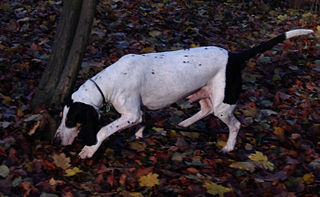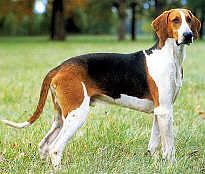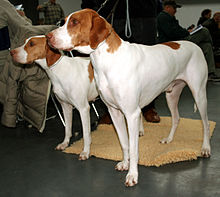
Scent hounds are a type of hound that primarily hunts by scent rather than sight. These breeds are hunting dogs and are generally regarded as having some of the most sensitive noses among dogs.
Pointing dogs, sometimes called bird dogs, are a type of gundog typically used in finding game. Gundogs are traditionally divided into three classes: retrievers, flushing dogs, and pointing breeds. The name pointer comes from the dog's instinct to point, by stopping and aiming its muzzle towards game. This demonstrates to the hunter the location of their quarry and allows them to move into gun range. Pointers were selectively bred from dogs who had abundant pointing and backing instinct. They typically start to acquire their hunting instincts at about 2 months of age.

The Drentsche Patrijshond is a versatile spaniel-type hunting dog from the Dutch province of Drenthe. Called the Dutch Partridge Dog in English, approximately 5,000 dogs are registered with the breed club in the Netherlands, and breed clubs operate in Belgium, Denmark, Scandinavia and North America. The Drentsche Patrijshond bears some resemblance to both spaniel and setter types of dog. An excellent pointer and retriever, this dog is often used to hunt fowl and adapts equally well to the field or marshes.

The Small Münsterländer is a versatile hunting-pointing-retrieving dog breed that reached its current form in the area around Münster, Germany. The Large Münsterländer is from the same area, but was developed from different breeding stock and is not related as the names would suggest. Small Münsterländers bear a resemblance to both spaniels and setters but are more versatile while hunting on land and water. The Small Münsterländer is recognized by the Fédération Cynologique Internationale under Group 7, Section 1.2, Continental Pointing Dogs of Spaniel type, by the American Kennel Club as a Foundation Stock Service breed, and by The Kennel Club and the United Kennel Club as a gun dog. It is related to the Epagneul Français and the Drentsche Patrijshond.
The American Rare Breed Association or ARBA is a national dog association of the United States, based in Cheltenham, Prince George's County, Maryland. The club was formed to register, show, educate and promote the breeding of uncommon dog breeds. ARBA handles breeds recognized by the Fédération Cynologique Internationale or by its own board of directors that are not yet recognized by the American Kennel Club.

The French Spaniel is a breed of dog of the Spaniel-like setter. It was developed in France and Canada as a hunting dog, descended from dogs of the 14th century. Popular with royalty during the Middle Ages, it nearly became extinct by the turn of the 20th century but was saved by the efforts of Father Fournier, a French priest. One of the largest breeds of Spaniel, it typically has a white coat with brown markings. It is a friendly breed that has few health issues, but can be affected by a syndrome called acral mutilation and analgesia. The breed is recognised by Canadian and international kennel clubs but not by The Kennel Club (UK). The American Kennel Club has included the breed in its Foundation Stock Service, the first step to full recognition.

The Basset Bleu de Gascogne, also known as the Blue Gascony Basset, is a long-backed, short legged breed of dog of the hound type. The breed originated in the Middle Ages, descended from the Grand Bleu de Gascogne. It nearly became extinct around the early 19th century; its salvation was attributed to one Alain Bourbon. A French native breed, it is rare outside its homeland. It is recognized internationally by the Fédération Cynologique Internationale, in the UK by The Kennel Club, and by the United Kennel Club in the United States. The "bleu" of its name is a reference to its coat which has a ticked appearance.

The Ariegeois is a breed of dog from the département of Ariège in the Midi-Pyrenées region of southern France. It is a medium-sized pack-hunting scenthound deriving from crossing of Grand Bleu de Gascogne and Grand Gascon-Saintongeois hounds with local Briquet dogs. It is used both as a courser and for driving game to waiting guns. While most successful with hares, it is also used for hunting deer and boar. It is distinguished by its friendly nature with other hounds and affection for human companions.

The Drever is a breed of dog, a short-legged scenthound from Sweden used for hunting deer and other game. The Drever is descended from the Westphalian Dachsbracke, a type of German hound called Bracke. The breed name Drever was chosen through a contest in 1947.

The Anglo-Français de Petite Vénerie is a medium-sized breed of dog used in hunting as a scenthound, usually in packs. It is one of the Anglo-French hound breeds which were created by crossing French scenthounds with English (Anglo) foxhounds. The name Petite Vénerie does not mean that dogs of the breed are petite or small, but rather that it is used to hunt small game.
The North American Versatile Hunting Dog Association was founded 1969 in Goodwood, Ontario, Canada by a group of pudelpointer and griffon enthusiasts. Presently based in Arlington Heights, Illinois, NAVHDA "is a nonprofit corporation whose purpose is to foster, promote, and improve the versatile hunting dog breeds in North America; to conserve game by using well trained reliable hunting dogs before and after the shot; and to aid in the prevention of cruelty to animals by discouraging nonselective and uncontrolled breeding, which produces unwanted and uncared for dogs." The group has chapters in most states of the U.S. and provinces of Canada which sponsor training and testing programs.

The Braques français are hunting dogs, from a very old type of gun dog used for pointing the location of game birds for a hunter. There are two breeds of Braque français, both from the south of France, the Braque français, type Gascogne and the Braque français, type Pyrénées They are popular hunting dogs in France, but are seldom seen elsewhere.

The Basset Artésien Normand is a short legged hound type dog developed in France. The word basset refers to short-legged hounds.
Anglo-Français and Français hounds are a general type of hunting dogs that include ancient French hounds and breeds created by mixing the French dogs with English (Anglo) Foxhounds. There are seven dog breeds that are described as Anglo-Français and Français hounds.

The Grand Anglo-Français Blanc et Noir translated into English as the Great Anglo-French White and Black Hound, is a breed of dog used in hunting as a scenthound, usually in packs. It is one of the Anglo-French hound breeds which were created by crossing French scenthounds with English (Anglo) Foxhounds.

The Braque du Puy was an old breed of hunting dog in France, bred for hunting in the lowlands and known for being fast and flexible. The breed was created in Poitou in the 19th century by crossing other Braques with greyhound-type dogs. One story is that two brothers named du Puy crossed their Braque Francais dog with a Sloughi brought back from Africa by a French soldier.























